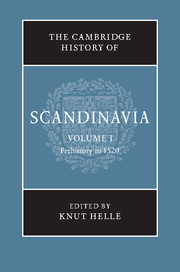Book contents
- Frontmatter
- Introduction
- PART I THE GEOGRAPHY AND PREHISTORY OF SCANDINAVIA
- PART II FROM VIKINGS TO KINGS
- PART III MATERIAL GROWTH (to c. 1350)
- PART IV THE HIGH MEDIEVAL KINGDOMS
- 12 Towards nationally organised systems of government
- (a) Introductory survey
- (b) The Danish kingdom: consolidation and disintegration
- (c) The Norwegian kingdom: succession disputes and consolidation
- (d) Sweden under the dynasty of the Folkungs
- (e) Growing inter-Scandinavian entanglement
- 13 Church and society
- PART V HIGH AND LATE MEDIEVAL CULTURE
- PART VI LATE MEDIEVAL SOCIETY (c. 1350–1520)
- PART VII SCANDINAVIAN UNIONS (1319–1520)
- Conclusion
- Select bibliography: primary sources, general surveys and secondary works arranged by part
- Index
- Plate Section"
- References
(d) - Sweden under the dynasty of the Folkungs
from 12 - Towards nationally organised systems of government
Published online by Cambridge University Press: 28 March 2008
- Frontmatter
- Introduction
- PART I THE GEOGRAPHY AND PREHISTORY OF SCANDINAVIA
- PART II FROM VIKINGS TO KINGS
- PART III MATERIAL GROWTH (to c. 1350)
- PART IV THE HIGH MEDIEVAL KINGDOMS
- 12 Towards nationally organised systems of government
- (a) Introductory survey
- (b) The Danish kingdom: consolidation and disintegration
- (c) The Norwegian kingdom: succession disputes and consolidation
- (d) Sweden under the dynasty of the Folkungs
- (e) Growing inter-Scandinavian entanglement
- 13 Church and society
- PART V HIGH AND LATE MEDIEVAL CULTURE
- PART VI LATE MEDIEVAL SOCIETY (c. 1350–1520)
- PART VII SCANDINAVIAN UNIONS (1319–1520)
- Conclusion
- Select bibliography: primary sources, general surveys and secondary works arranged by part
- Index
- Plate Section"
- References
Summary
The account of the early history of Swedish political developments in Chapter 8(e) ends in the middle of the thirteenth century when Sweden began to take shape as a high medieval European kingdom. The following section is devoted to the development of that kingdom until the downfall of the Folkung dynasty in the 1360s.
A new dynasty
When King Erik Eriksson died childless in 1250 his nephew Valdemar, son of the factual ruler Earl Birger and still a minor, was chosen to succeed him. Thus was established what has traditionally, but incorrectly, been called the dynasty of the ‘Folkungs’ (Swedish folkungar). The focal point of the realm was in the course of being transferred from the provinces of Västergötland and Östergötland to the Mälar valley. There, the uprising led by the aristocratic clan of the real folkungar had been crushed in 1247, an event that speeded up the transition from personal military service to taxation of the peasant community of Uppland (cf. Chapter 8(e)). In 1248 a papal legation had led to a significant agreement between the temporal and spiritual powers. Secular cathedral chapters were now established with the support of king and aristocracy. Uppsala’s position as the centre of the Swedish church was thereby strengthened, and in the following century the archbishop and his chapter supported the royal power. About the same time Earl Birger had led a successful military action in Finland and subjugated the Tavasts, who, from their central position in the country, had controlled the coastal regions to the west and south.
Keywords
- Type
- Chapter
- Information
- The Cambridge History of Scandinavia , pp. 392 - 410Publisher: Cambridge University PressPrint publication year: 2003
References
- 1
- Cited by

